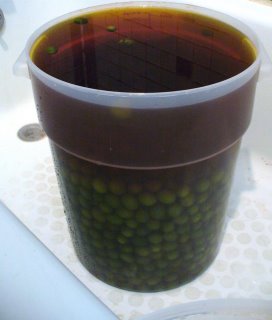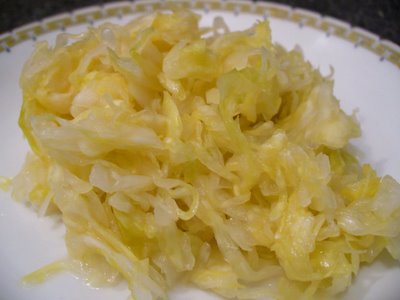Semi(Legal) Homemade

Laura!
Laura Ingalls!
You come on in this house right now before your Pa comes home from gettin' his wagonwheel fixed at the blacksmith!
I don't know about you, but Fall is becoming one of my favorite seasons to get my hippie, back-to-the-land, survivalist, frontier settler, Little House on the Prairie, foodie freak on. From curing to drying to pickling to smoking – it's all about taking Summer and making it last a little bit longer.
If you're successful, this can be the mostest funnest time of year to make things "homemade".
If you're not successful, you could die a horrible death from botulism – which, I've read, isn't fun at all.
Nevertheless, for what it's worth, Bruce and I have been doing our part curing olives for the last 3 years and, so far, no one's dead.
Yet.

This year is no exception and last Sunday we got our hands dirty picking beautiful, large green olives from our semi-legal picking spot. Being citified, I have all kinds of romantic, idealistic images and notions when it comes to picking fruit off of a tree.
I envision myself picking olives (or peaches) wearing faded denim overalls, a blue-checked, gingham button-down shirt, and a cap, all while singing a Woodie Guthrie song. Five minutes later, a couple of bleeding scratches, dirt and dust in my face and hair, bugs crawling in my ears and nose, and Woodie Guthrie can go to hell.
The real payoff comes when the work is done, we're back in an air-conditioned car listening to Sufjan Stevens, and headed back to the land of steel canyons, latte sippers, and pigeon shit.
 Olives during the lye bath
Olives during the lye bathCuring green olives, while seemingly simple, is often a hit or miss operation, or at least it has been for us. Last year, just when I thought I had perfected the curing recipe, Bruce one upped me and made crisp and clean tasting olives. From his batch, we learned to reduced the amount of lye, extend the period of lye-soaking, and rinse and change the water often.
 Pouring off the solution of lye that SUCKS the Oleuropein (bitter compound) out of the olive...suck, lye, suck!
Pouring off the solution of lye that SUCKS the Oleuropein (bitter compound) out of the olive...suck, lye, suck!We've also been lucky that the olives we've picked lately have been spared the extensive damage that can be caused by the olive fly, which by the way, wasn't a problem in California until recently.
As of this writing, we're still in the rinsing phase that lasts 7 days or longer. This is after the 16-hour lye bath at half of the strength I used previously.
Already, we've encountered a problem.
Today, the olives turned a dark, dark green – some of them almost black. We believe this happened because we left them out of the rinse water, twice, for 30 minutes at a time in between changes of fresh water. I seem to remember that last year I had a similar problem, but that they lightened over time (later on in the day, they lightened up some).
 In freshly changed water
In freshly changed waterIt's not unusual for green olives to turn black during the lye-curing process. In fact, this accident is what gave Americans the ubiquitous canned "black-ripe" California olive that is so pervasive in salad bars and pizza parlors across the U.S. The black-ripe olive is actually a firm, unripe green olive that has been lye-cured and then oxidized to turn black, while ferrous gluconate is added to retain its color.
A real black olive is a fully ripe one that has turned from green to purple to black throughout the season, is soft and oily, and generally used to make olive oil (and sometimes salt-cured table olives).
You may be wondering, "why lye-cure an olive when a water-cured/fermented or salt-cured one has more flavor?"
Well, that's a good question. In fact, I love Kalamata olives, which are cracked, water-cured, fermented olives that have had red wine vinegar added at the last stage. And actually, Bruce and I do make salt-cured black olives, known also as "Moroccan oil cured" olives, as well as fermenting lye-cured green olives (although, in hindsight, that didn't work as well as I thought it would). But lye-cured green olives have special characteristics of their own.

Contrary to some naysayers, lye-cured green olives aren't without flavor. In fact, on their own, their flavor is often described as buttery (perhaps due to the fat content of the olive) and mild. For those who like spicy or garlicky olives, lye-cured green olives are perfect candidates for infusing with peppers, garlic, vinegar, and other spices.
That's likely what we'll do with this batch we're making now, although I'll probably set some "unflavored" ones aside, since I like them the way they are. One day we'll try curing the green olives without lye, but for now we're keeping a container of Red Devil handy.
Next Post: Our favorite smelly cabbage dish - Liberty Cabbage?
No! Sauerkraut! Yum, yum, yum. And I'll show you how to can it!
Added bonus: Fermented veggie pickles!
Start puckering your lips...

k.
 Hello and welcome. This food blog is based in San Francisco and I'm Kevin, the guy who writes it.
You may know me from my brief, but violent and cracked out, appearance on COPS. Actually, that wasn't me - he didn't even look like me.
I'm more than happy to entertain you, but please don't be so shy. You can comment below or contact me personally at baconprss at yahoo dot com. Oh, and I like to eat sometimes.
Hello and welcome. This food blog is based in San Francisco and I'm Kevin, the guy who writes it.
You may know me from my brief, but violent and cracked out, appearance on COPS. Actually, that wasn't me - he didn't even look like me.
I'm more than happy to entertain you, but please don't be so shy. You can comment below or contact me personally at baconprss at yahoo dot com. Oh, and I like to eat sometimes.

5 Comments:
I totally didn't get botulism on the batch you sent me. Thanks for that!
Biggles
Molly,
I seem to remember that you live down on the Peninsula.
Did you know there are many fruit-bearing olive trees on the Canada College campus in Redwood City?
By the way, it takes about 30 minutes with the help of another person to pick 3-5 gallons of olives.
Just a friendly tip.
k.
Olive curing sounds like a lot of work, but fun.
Hello, I need you Liberty Cabbage help!!! I have two weeks worth in my pantry and I have no idea if I'm doing it right!!
Seriously,
Mikey
curing olives...really cool!
btw, I just got back from out of town, and I owe you an email.
karen
Post a Comment
<< Home